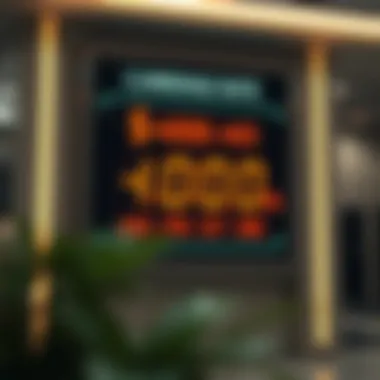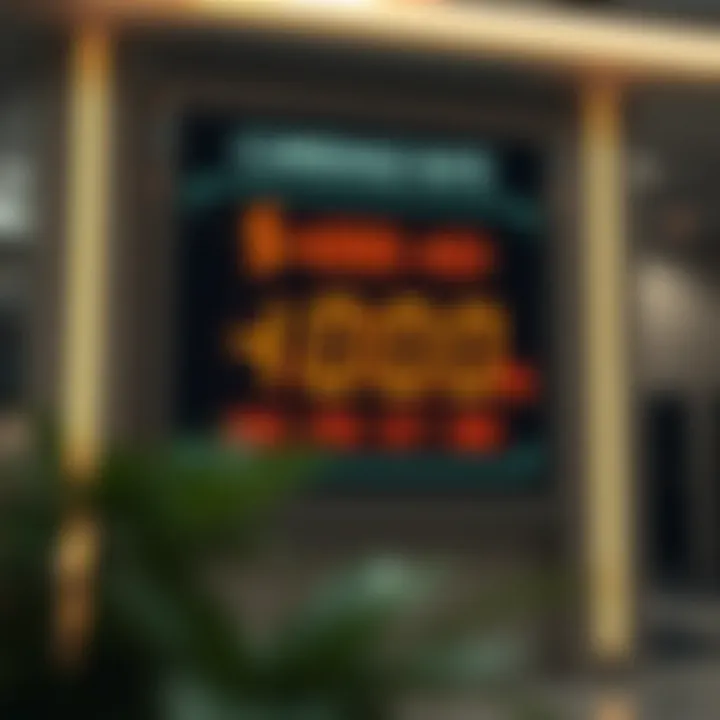Converting $4000 to AED: Financial Insights for Investors


Intro
In today's fast-paced economic landscape, understanding currency conversion can have a significant impact on your financial decisions, especially for potential investors in Dubai's gilded terrain. The inquiry into how $4000 translates into the United Arab Emirates Dirham (AED) doesn't just stop at the numbers. It opens up a broader discussion, one that encapsulates historical context, economic frameworks, and future implications.
The United States dollar holds a steadfast position as one of the world's predominant currencies, while the AED operates within a tightly controlled exchange framework against the USD. Thus, exploring this conversion presents an opportunity to grasp not merely the transactional aspect, but also the market dynamics at play.
What’s more, Dubai's real estate market continues to be a point of intrigue for many, beckoning investors with the promise of profitable returns. Navigating this landscape with a solid understanding of currency fluctuations can provide a strategic edge. With that in mind, let’s delve into the intricacies of the current market conditions in Dubai, illuminating vital indicators and strategies that can guide property investments.
Understanding Currency Conversion
Currency conversion is at the heart of global transactions, making it a critical part of any financial decision, notably in real estate investments. When one talks about converting dollars to Dirhams—or indeed any currency pair—there's a lot more than just numbers involved. Understanding how and why currency conversions matter can significantly impact both individual and business economic strategies.
Engaging in currency conversion isn’t just about the current exchange rate; it reflects broader economic scenarios. For investors, recognizing the nuances of currency conversion is essential. Speculating on movements in exchange rates can lead to bountiful gains, but a lack of knowledge may usher in severe losses. Thus, delving into the underpinnings of currency exchange lays the foundation for sound investment choices and financial forecasts.
Basics of Currency Exchange
To comprehend currency exchange, one must first grasp what currencies represent. Currencies, in essence, signify the economic health of a nation. Each unit of currency reflects its purchasing power, which varies according to a host of factors, most notably economic indicators and geopolitical stability.
In the practical sense, currency exchange involves trading one currency for another, typically driven by market demand and supply. For instance, if more people want Dirhams than dollars, the price of the Dirham could rise relative to the dollar. Investors must consider the cost of conversion—a fee charged by banks or exchange platforms—always keeping in mind that these costs can chip away at potential profits.
Factors Influencing Exchange Rates
The foundation of understanding currency conversion lies deeply in the factors that influence exchange rates. Three primary players in this arena are inflation rates, interest rates, and political stability.
Inflation Rates
Inflation rates pose a meaningful consideration when we discuss their influence on currency valuation. Simply put, when inflation in a country rises, its currency typically depreciates against others, as purchasing power erodes. This correlation makes inflation a key indicator for investors.
Investors should keenly monitor these rates, as they often provide clues about economic trends. For instance, if inflation is soaring in the U.S., the dollar's value could diminish compared to the Dirham, impacting investors looking to make trades in AED. However, inflation can also indicate a recovering economy, which could tempt investors into playing the waiting game for potential rebounds.
Interest Rates
Interest rates not only affect lending and borrowing but also act as a magnet for foreign investment. Higher interest rates tend to attract international investors hunting for better returns on their investments. In a competitive landscape, if the U.S. offers higher interest rates than the UAE, it could lead to a stronger dollar as investors flock to capitalize.
Conversely, lower interest rates might prompt investors to look elsewhere, which could erode the currency's strength. Thus, keeping a close eye on these rates is a cardinal rule for making informed decisions regarding currency conversion and investments.
Political Stability
Political stability and potential turbulence shape the currency markets significantly. A stable political environment fosters confidence among investors, while uncertainty generally results in currency depreciation. For example, a sudden political upheaval can deter foreign investment entirely, leading to plummeting currency values.
In the case of the UAE and the broader Middle Eastern region, the stability policies and economic strategies in place have bolstered AED’s position as a strong and secure currency. Investors often weigh this factor heavily when contemplating conversions from dollars to Dirhams, as local governance can significantly sway market sentiment and currency valuations.
Currency conversion is not an isolated action but rather a reflection of a complex interplay of economic indicators, market trends, and geopolitical landscapes.
Current Conversion Rate of USD to AED
Understanding the current conversion rate of the U.S. dollar to the United Arab Emirates dirham (AED) is crucial for anyone involved in cross-border transactions. This rate acts as a bridge for investors, homeowners, and business professionals operating in the UAE. Misreading this rate can lead to significant financial implications, impacting investments, purchases, and even daily expenses.
When you think about exchanging currency, it’s more than just one figure—it represents a variety of economic conditions and sentiments. For instance, if the dollar is strong against the dirham, a purchase of real estate in Dubai becomes slightly less burdensome for American investors. Conversely, if the dirham strengthens, American buyers might consider halting their intent to purchase or invest as the costs could rise unexpectedly.
Investors often analyze this rate carefully, weighing benefits versus risks in the fluid market. A solid grasp on the conversion rate supports better decision-making, particularly in the real estate sector. Understanding where the currency stands today can provide insights on whether it is wise to accelerate investments or perhaps hold off until conditions become more favorable.
How Rates are Determined
Conversion rates are not just arbitrary numbers; they stem from a complex interaction of factors. Major contributors to determining the adaptation of the USD to AED exchange rate include:
- Market Demand and Supply: If there's high demand for USD in the UAE, the value might spike against the dirham. Conversely, an increased supply could devalue it.
- Inflation Rates: A country experiencing high inflation typically sees its currency depreciate in relation to more stable currencies like the USD.
- Policy Decisions: Central bank policies greatly influence currency values, including interest rates and foreign exchange reserves.
It makes sense, then, to understand these elements when evaluating the current conversion rate. It helps to look beyond the surface and seek signs of stability or volatility in the markets.


Where to Find Up-to-Date Rates
Keeping track of the latest conversion rates can be quite the task; however, several reliable resources exist to assist. You might consider:
- Finance Websites: Websites like xe.com or oanda.com are invaluable for checking real-time conversions. They also offer analytical tools that let you see trends over time.
- Bank Services: Most major banks provide their exchange rates, often displayed on their websites or through customer service.
- Currency Converter Applications: Apps such as Revolut or Currency Converter Plus can track exchange rates on the go, making it convenient for investors or real estate buyers.
Always cross-reference multiple sources to get the most accurate understanding, as rates can fluctuate quickly due to market dynamics. As you navigate these waters, having the most recent information can empower your financial choices.
Calculating the Conversion of $4000 to AED
When it comes to navigating the complexities of international currency exchange, especially for the UAE Dirham, grasping the process of conversion is vital for any investor or traveler. Knowing how to convert $4000 into AED not only aids in effective budgeting but also provides insights into buying power, investment opportunities, and the overall economic landscape of Dubai.
Understanding the conversion method allows individuals to make informed financial decisions. This includes assessing when to convert currency while keeping an eye on exchange rate fluctuations. By calculating the conversion accurately, potential investors can anticipate costs more effectively, be it in real estate purchases, business ventures, or everyday expenses.
Step-by-Step Calculation
Calculating the conversion of $4000 to AED involves straightforward arithmetic, but the devil is in the details. Here's how to approach it:
- Identify the Current Exchange Rate: The first step is to acquire the latest USD to AED exchange rate. This can change daily, sometimes even hourly, based on market dynamics. For instance, if the rate is 3.67 AED for 1 USD, you’d use that as your base.
- Perform the Calculation: Multiply the amount you wish to convert (in this case, $4000) by the current exchange rate. Using our example:4000 USD × 3.67 AED/USD = 14680 AED
- Consider Additional Fees: Depending on the method of conversion—whether through bank services, currency exchange counters, or online applications—additional fees may apply. These charges can reduce the final amount you receive. Always factor this in to get a clearer picture of your available funds.
- Stay Informed: To ensure you’re making the best decisions, keep an eye on market trends and economic reports that can influence exchange rates.
Tools for Quick Conversion
For those who prefer convenience, several tools can help streamline the currency conversion process:
- Currency Converter Apps: Mobile applications like XE Currency and OANDA provide real-time conversion rates and can track historical changes, making them indispensable for travelers and investors alike.
- Online Currency Converters: Websites such as XE.com and OANDA.com offer straightforward conversion tools. Simply input your amount and select the currencies, and voila, it gives you the answer in seconds.
- Bank Services: Many banks have integrated currency conversion calculators within their online banking. This ensures you receive rates that are aligned with their internal processing rates, which can vary distinctively from market rates.
Historical Context of the USD and AED
Understanding the historical context of the USD and AED is crucial for grasping the dynamics of currency conversion and the overall economic landscape of the United Arab Emirates. The relationship between the U.S. dollar and the Dirham has been shaped by a variety of economic, political, and social factors that influence how currencies interact.
The Pegged Relationship
The United Arab Emirates dirham is pegged to the U.S. dollar at a rate of approximately 3.67 AED to 1 USD. This fixed exchange rate system brings stability to the economy, making it easier for international investors and expatriates in the UAE to transact. One of the significant advantages of this pegged relationship is that it lowers the risk associated with exchange rate fluctuations. Investors can predict costs and revenues with precision, which is particularly vital in sectors like real estate, where investment decisions hinge on currency stability.
However, the peg also presents challenges. If the U.S. dollar becomes too strong, it could make UAE exports more expensive and less competitive in the global market. On the other hand, a weaker dollar may enhance export prospects but could also drive inflation within the UAE. Knowing these nuances can enable investors and businesses to navigate the market better, thus making informed financial decisions.
Major Economic Events Impacting Rates
Global Financial Crises
Global financial crises, such as the one in 2008, played a significant role in shaping currency relationships worldwide, including that of the USD and AED. During the crisis, many currencies faced considerable volatility due to market uncertainty. The crash underscored the predictors of economic strength and stability, which consequentially made the pegged relationship between the Dirham and the U.S. dollar all the more vital.
A key characteristic of such crises is the lack of liquidity in markets, which can lead to fluctuations in exchange rates. In this turbulent environment, the USD often acts as a safe haven, driving many investors to convert their currencies into dollars. Understanding how these financial upheavals impact exchange rates is integral for anyone looking to invest in Dubai’s real estate market.
"Currency exchange can be a treacherous game during economic turmoil. Understanding the past helps in making wise choices for the future."
Oil Price Fluctuations
Oil price fluctuations have historically influenced economic stability in the UAE and, by extension, the relationship between the USD and AED. As one of the leading oil producers globally, changes in oil prices can affect the UAE's national revenue. For instance, when oil prices hit an all-time high, the UAE enjoys robust economic growth that boosts investor confidence, leading to a stronger Dirham against the dollar. Conversely, when prices plummet, uncertainty looms over the economy, potentially impacting its currency value.
What makes this correlation even more intriguing is how it connects to global economic trends and geopolitical factors. Investors must keep an eye on oil market reports and geopolitical news to anticipate shifts in the Dirham’s strength. This awareness is particularly beneficial for those looking to invest in property, as changes in overall economic health can directly influence real estate valuations.
Relevance of Currency Conversion in Real Estate
Understanding currency conversion plays a vital role in the realm of real estate, especially for investors and homeowners navigating the bustling market in Dubai. The ability to effectively convert USD to AED influences various aspects of property investment and ownership.
When considering real estate in an international context, currency conversion is not just a mathematical exercise. It's a lens through which to view the market. For someone converting $4,000 into AED, understanding the ramifications of exchange rates can lead to significant financial outcomes. Timing the conversion wisely can enhance purchasing power or even expose one to potential losses.


Investment Opportunities
In recent years, Dubai has emerged as a hotbed for real estate investment. From luxurious villas in Palm Jumeirah to high-rise apartments in Downtown Dubai, opportunities abound. However, success in this domain requires a grasp of currency dynamics.
For instance, an investor armed with AED might find properties listed at more attractive prices compared to one relying on USD. Fluctuations in the exchange rate can either benefit or hinder investment potential. Consider the following aspects:
- Buyer's Advantage: When the AED strengthens against the USD, local properties may be more appealing to foreign investors. This dynamic can lead to increased demand, ultimately driving prices up.
- Diverse Portfolio: Currency conversion provides opportunities to invest in various sectors, from residential to commercial properties without being limited by one's home currency.
- Leveraging Local Knowledge: By converting currency ahead of time, investors can lock in rates that will be beneficial, taking advantage of local market expertise and opportunities before the broader market reacts.
Impact on Property Pricing
The truth is, property pricing in Dubai isn’t solely dictated by location, amenities, or supply-and-demand; it’s also influenced by exchange rates. When the USD weakens, properties priced in AED may seem like bargains to American buyers. Conversely, a strong USD can deter investment, as the purchasing power diminishes. Here are some key implications:
- Price Fluctuation: Anomalies in exchange rates can lead to short-term spikes or drops in investment interest. If the rate swings favorably, there could be a rush toward purchasing, consequently inflating prices temporarily.
- Market Sentiment: Property pricing can also be impacted by investor sentiment tied to currency strength. If investors believe the AED will appreciate against the USD, they may be more inclined to invest now, propelling current prices higher.
- Financing and Mortgages: Local banks often offer loans in AED. For expatriates, understanding how exchange rates affect mortgage repayments is crucial. A fluctuating rate can increase monthly payments if revenues are not aligned with AED, leading to budgetary constraints.
In summary, currency conversion is more than just a numbers game; it intertwines deeply with investment strategies and market dynamics. By recognizing the worth of careful analytics and timing in conversion, investors can position themselves advantageously in the vibrant Dubai real estate market.
Strategies for Investors in Dubai
When it comes to investing in Dubai's dynamic real estate market, a deliberate strategy can make all the difference. Understanding the nuances of currency conversion, particularly when converting dollars to AED, is crucial. The strategies used here can significantly influence the return on investment and overall success in this vibrant market.
Making Informed Decisions
Investors must arm themselves with knowledge beforehand. Decisions made in haste can lead to missed opportunities or financial setbacks. Here are some factors to consider:
- Market Research: Keeping an eye on property prices and trends in specific neighborhoods of Dubai is essential. Areas like Dubai Marina and Downtown Dubai often attract premium prices, while locations slightly further out may offer more value.
- Currency Fluctuations: Understanding how the USD to AED conversion has shifted over time can help investors anticipate future costs. If the dollar strengthens against the dirham, it might be a good time to invest, whereas a weaker dollar might suggest waiting before converting any significant amounts.
- Legal Framework: Navigating the real estate laws in the UAE is key to making sound investment choices. Familiarizing oneself with regulations around foreign ownership and property rights can prevent unexpected hurdles.
- Engaging Professionals: Consulting with real estate agents or financial advisors who specialize in the Dubai market can provide invaluable insights. They can highlight opportunities that investors might otherwise overlook.
When to Convert Currency
Timing is everything in the investment game, particularly when doing currency conversions. Here’s how to decide the best time to convert your $4000 to AED:
- Monitoring the Rates: Currency rates fluctuate continuously, influenced by various factors such as economic news, geopolitical events, and market trends. Using apps or websites that track conversions can keep investors updated.
- Identify Patterns: Historical data can sometimes reveal patterns in currency movements. For instance, if the USD has typically strengthened during certain months, it could be worth converting then.
- Economic Indicators: Learning about global economic indicators can provide context for currency movements. For example, changes in U.S. interest rates or inflation can impact the dollar's strength against the dirham.
- Avoiding Panic Conversions: It’s easy to rush decisions in response to immediate market changes. It's advisable to remain level-headed and make data-driven decisions rather than acting out of fear or undue pressure.
"In the realm of investment, knowledge is your best ally. Not converting at the right time can drain your potential profits."
Investing in Dubai can yield great returns, but investors must approach with caution and strategic thinking. By making informed decisions and timing currency conversions wisely, they position themselves for success in a competitive landscape.
Utilizing Financial Tools
When dealing with currency exchange, especially in a dynamic market like that of the United Arab Emirates, it's crucial to wade through the sea of information with the right set of financial tools. The idea here is to capitalize on the latest technology to make informed decisions during currency conversion. Investors need to navigate through both opportunities and risks, and financial tools help in this pursuit.
Currency Converter Applications
In today's digital age, currency converter applications serve as essential allies for investors dealing with currency conversions. These applications do more than just provide exchange rates; they also offer real-time updates and detailed insights that can aid in decision-making. For instance, applications like XE Currency and OANDA boast of user-friendly interfaces and extensive features that satisfy the need for precision in modern financial transactions.
Benefits include:
- Real-Time Data: Updated conversion rates allow investors to capitalize on favorable conditions.
- Historical Data Analysis: Understanding past trends can provide context for current market behavior.
- Ease of Use: Mobile access means currency rates are just a tap away, allowing swift action when an opportunity arises.
But, not everything shines bright. It's important to assess these apps critically. Some may offer rates that include hidden fees or conversion surcharges. Always read the fine print before relying solely on a digital tool.
Bank Services for Currency Exchange
Another important component in utilizing financial tools is engaging with bank services dedicated to currency exchange. Traditional banks like HSBC or Emirates NBD often provide a range of options for currency conversion, often with personalized services. Unlike many applications, banking institutions may offer more stable rates due to their standing in the market, which often reflects a more reliable conversion when large sums are involved.
Key considerations include:
- Personal Interaction: A chance to discuss currency strategies with banking specialists who offer valuable insights based on their experience.
- Competitive Rates: Well-established banks are known to provide rates that are competitive when compared to digital apps, especially for larger transactions.
- Security: Dealing through banks ensures a level of security and trust, reducing the risk of fraud.
However, be wary of service fees or delays in conversion times, as banks can sometimes lag behind in terms of instant updates when compared to technology-based apps. Knowing when to lean towards the advantage of a bank’s services versus when to use a currency converter application could very well define one’s success in their investment endeavors.


"The right tools in the world of currency exchange can mean the difference between profit and loss, making it essential for investors to stay informed."
Potential Risks in Currency Fluctuations
When discussing currency conversion, particularly the transition from US dollars to the United Arab Emirates Dirham, understanding the associated risks is critical for investors, homeowners, realtors, and developers alike. Currency fluctuations can greatly impact the value of an investment and can affect anything from property pricing to the overall economic environment. Thus, being cognizant of these elements is essential for informed decision-making.
Market Volatility
Market volatility refers to the rapid and unpredictable changes in currency values. For investors dealing with USD to AED conversions, fluctuations can happen due to various factors, such as sudden economic news, changes in interest rates, or unexpected geopolitical events. For instance, if the US Federal Reserve hints at a rate hike, it might strengthen the USD against the AED. Conversely, negative economic data from the UAE might weaken the Dirham.
Keeping a keen eye on market trends can provide insights into when to make conversions. For example:
- Upward trends typically suggest a favorable time to convert to AED, capturing a higher exchange value.
- Downward trends might indicate waiting could yield better rates.
Impact of Geopolitical Factors
Geopolitical stability plays a pivotal role in currency conversion. Changes in political climates — such as elections, conflicts, or trade agreements — can swing exchange rates rapidly. In regions like the Middle East, known for its complex geopolitical landscape, developments can lead to uncertainty, causing investors to hesitate or leap into conversions. For example:
- If tensions rise between major economies, investors may flock to more stable currencies, influencing their values.
- A peace agreement could lead to an increase in local investment, strengthening the AED.
Broadly speaking, staying informed about geopolitical events, such as those reported by Reuters or BBC, can highlight the right moments for currency exchanges.
Investors should consider integrating these insights into their financial strategies, keeping in mind that managing risks is as significant as seizing opportunities. Ignorance could potentially lead to losses, while awareness can bring about financial gains.
Future Outlook for USD-AED Conversion
The future of USD to AED conversion bears significance that is manifold. This section explores how the dynamics of currency exchange might unfold in the coming times while illuminating important aspects that could either bolster or hinder the process. Investors, especially those eyeing the real estate market in Dubai, need to consider trends and predictions that stem from global economic shifts.
Expert Predictions
When looking ahead, experts do not shy away from voicing their perspectives on the USD/AED currency pair. Many financial analysts take into account several variables that influence currency behaviour. One significant element is the anticipated performance of the U.S. economy. If the American economy continues on its upward trajectory, many foresee a relatively stable conversion rate. Evaluating market sentiment, inflation figures from the U.S., and geopolitical stability can enable investors to make educated assessments about changes in conversion rates.
- Supply and Demand: Given the pegged nature of AED to USD, changes in demand for the dollar can influence this relationship. Increased investment in the UAE may strengthen Dirham's position against other currencies, including the USD.
- Interest Rates: The direction the U.S. Federal Reserve takes with interest rates can drastically shift the conversion rate. Higher rates often lead to a stronger dollar, while lower rates may weaken it.
- Oil Prices: As a major global oil supplier, UAE's economy is interlinked deeply with oil prices. A significant rise in oil demand could bolster AED, influencing its value against USD.
Long-Term Trends to Consider
Looking further down the lane, there are trends that shape the currency conversion landscape. Being aware of these influences can equip investors with the necessary tools to navigate their financial strategies effectively.
- Regional Economic Growth: UAE is focusing on diversifying its economy beyond oil. Initiatives like Expo 2020 and investments in technology may lead to a more robust economic framework, impacting currency strength.
- Bilateral Trade Agreements: New trade agreements between the U.S. and Middle Eastern countries might create a ripple effect, affecting the dollar's strength. A favorable environment for trade can see a surge in USD demand, influencing its relationship with AED.
- Global Economic Climate: At times, it might feel like navigating a minefield due to fluctuating global sentiments. Economic downturns, pandemics, and other unforeseen events can cause significant volatility in currency exchange rates, calling for prudent investment decisions.
Staying attuned to these predictions and trends not only helps in making informed decisions but creates an avenue for seizing opportunities as they arise.
Understanding the future outlook for USD-AED conversion is essential for investors and stakeholders who wish to navigate the ever-changing economic landscape confidently. This serves as a clarion call to embrace continuous education and responsiveness to the shifting tides that currency markets often present.
Ending
Understanding the intricacies of currency conversion, particularly when it comes to turning dollars into dirhams, is more than just a simple calculation. It's a gateway to better financial decisions in a landscape as vibrant as the Dubai real estate market. This section aims to knit together the threads of knowledge that have been woven throughout the article, highlighting key takeaways and why they matter in the grand scheme.
Summarizing Key Insights
First and foremost, the exchange rate of the USD to the AED is dictated by multiple factors – economic stability, inflation, and even global events. Recognizing this can help investors gauge when to convert their currency and seize opportunities as they arise. Additionally, the historical ties between the two currencies display a consistent pattern of stability, reinforced by the UAE's economic policies. Here are some critical points:
- Pegged rate: The USD-AED relationship operates on a fixed exchange rate, providing a level of predictability.
- Market conditions: Investors must stay attuned to local and global market fluctuations that could impact this fixed relationship.
- Strategic conversion: Knowing when the time is right to convert will make or break your investment positioning.
By consolidating these insights, investors can lay a solid foundation for their future financial moves in real estate.
Final Thoughts for Investors
For anyone looking to navigate the waters of investing in Dubai's real estate market, remember that knowledge is your best ally. Not only does understanding currency conversion processes breaststroke your way to informed decisions, but it also grants you the ability to anticipate market changes. As currency fluctuations can pose potential risks, keeping an eye on geopolitical situations or changes in interest rates is crucial.
To sum it up, whether you're investing in luxurious villa developments or commercial spaces in Dubai, the conversion of $4000 to AED is a pivotal factor.
- Stay updated on current conversion rates.
- Leverage technology, utilizing apps and financial tools for quick conversions.
- Digest insights from financial experts to inform your strategy.
In this ever-changing market, equip yourself with relevant knowledge. Conversion might just seem like numbers on a screen, but it translates into real opportunities that can lead to substantial gains.
Remember, it’s not merely about numbers; it's also about timing and context in the vast financial landscape of Dubai.







